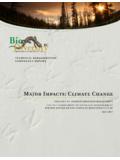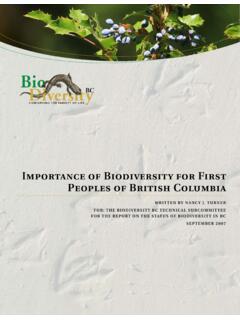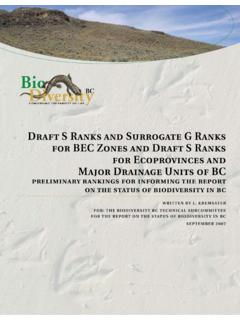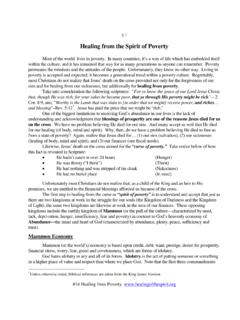Transcription of Ecological Concepts, Principles and Applications to ...
1 Ecological Concepts, Principles and Applications to Conservation2008 Ecological Concepts, Principles and Applications to Conservation2008 Library and Archives Canada Cataloguing in Publication DataMain entry under title: Ecological concepts, Principles and Applications to conservationEditor: T. Vold. Cf. 978-0-7726-6007-71. Biodiversity conservation. 2. Biodiversity. 3. Ecosystem management. I. Vold, Terje, 1949 . II. Biodiversity 2008 C2008-960113-0 Suggested citation: Vold, T. and Buffett (eds.). 2008. Ecological Concepts, Principles and Applications to Conservation, BC. 36 pp. Available at: photos: Jared Hobbs (western racer); Arifin Graham (footprints in sand).Banner photos: Bruce Harrison (p. 1); iStock (p. 7, 19).Design and Production: Alaris DesignTa le o ContentsAbout This Document vAcknowledgements vi1. What is Biodiversity? 12. Ecological Concepts and Principles 73. Application of Ecological Concepts and Principles 19 Glossary 32 List of Figuresf gu.
2 Examples of Biodiversity Components and Attributes 2f gu 2. The Contribution of Biodiversity to Human Well-Being 3f gu 3. Overview of Concepts, Principles and Applications 5Ac no ledge entsThe document was prepared by Biodiversity BC under the direction of its Technical Subcommittee, whose members reviewed and provided comment on various drafts. Members of the Technical Subcommittee include: Matt Austin, Ministry of Environment, Dan Buffett, Ducks Unlimited Canada, Dave Nicolson, Nature Conservancy of Canada, Geoff Scudder, The Nature Trust of British Columbia, Victoria (Tory) Stevens, Ministry of Biodiversity BC secretariat supports the work of the Steering Committee and the Technical Subcommit-tee and provides ongoing strategic advice. The secretariat consists of Stuart Gale, executive director, and Janet Fontaine, document was prepared under contract by Terje Vold with project direction and contributions by Dan Buf-fett on behalf of Biodiversity BC.
3 Three experts kindly agreed to be interviewed as part of this project and provided valuable reference material and ideas that have been incorporated into the document: Fred Bunnell, University of British Columbia, Faculty of Forestry; Ken Lertzman, Simon Fraser University, School of Resource and Environmental Management; and John Reynolds, Simon Fraser University, Department of Biological Sciences. John Reynolds, Ken Lertzman, Kaaren Lewis, Doug Biffard, Andrew Harcombe, Kristy Ciruna, Dianna Colnett, Michael Dunn, Liz Williams and Bruce Harrison reviewed and commented on an initial draft; Holling and Gordon H. Orians kindly reviewed and provided feedback on a subsequent draft; and a final draft received the benefit of further review and comment by Fred Bunnell, Carmen Cadrin and John Richardson. David Greer edited the report and Arifin Graham designed it. A o t t is doc entThe purpose of this document is to provide a primer on the concepts and Principles that support cooperative ac-tions to conserve s rich biodiversity.
4 As a companion piece to Taking Nature s Pulse: The Status of Biodiversity in British Columbia, this document is intended to stimulate public discussion about how best to identify and implement priority actions for biodiversity conservation in this document was prepared by Biodiversity BC, a partnership of government and non-government organiza-tions with a mandate to produce a biodiversity strategy for British BC Partner groups: Ministry of Agriculture and Lands, Ministry of Environment, Canadian Parks and Wilderness Society (representing environmental non-government organizations), Ducks Unlimited Canada, Environment Canada, Habitat Conservation Trust Foundation, Metro Vancouver (representing the Union of British Columbia Municipalities), Nature Conservancy of Canada, Pacific Salmon Foundation, The Land Conservancy of British Columbia, and The Nature Trust of British document consists of three parts: 1. What is biodiversity?: a definition of biodiversity and its value; 2.
5 Ecological concepts and Principles : general understandings and assumptions about biodiversity; and 3. Application of Ecological concepts and Principles : ways to maintain biodiversity including what can be done and how to do it. g , 1 W at is Biodiversity? Defining BiodiversityThe Canadian Biodiversity Strategy defines biodiversity as the variety of species and ecosystems on Earth and the Ecological processes of which they are a part including ecosystem, species, and genetic diversity components. The United Nations Convention on Biological Diversity provides a similar definition for biodiversity: the variability among living organisms from all sources including, inter alia [among other things], terrestrial, marine and other aquatic ecosystems and the Ecological complexes of which they are part; this includes diversity within species, between species and of ecosystems. In short, the term is used to refer to life in all its forms and the natural processes that support and connect all life forms.
6 Biodiversity is not easily defined because it is more than just the sum of its parts, as all of its elements, regardless of whether we understand their roles or know their status, are integral to maintaining functioning, evolving, resilient ecosystems. Complex concepts such as biodiversity are often easier to grasp if reduced to their component pieces. While this approach does not give a complete picture of how these pieces interact and combine to create biodiversity, it helps us understand different aspects of levels of organization of biodiversity include ecosystems, species and genes. An ecosystem is a dynamic complex of plant, animal and microorganism communities and non-living (abiotic) elements, all interacting as a functional unit. An ecosystem s character changes as community 2 g , EcosystemEcosystems in an areaPatch sizeConnectivitySpeciesSpecies richness in an areaAbundancePredator/prey dynamicsGeneticNumber of unique genes in a populationRelative abundance of each unique gene in a populationAdaptationCOMPONENT/ATTRIBUTE COMPOSITION STRUCTURE FUNCTION members and physical contexts change, sometimes crossing a threshold of tolerance within the system that results in its inability to return to its previous form.
7 Species are a complete, self-generating, unique ensemble of genetic variation, capable of interbreeding and producing fertile offspring. They (and their subspecies and populations) are generally considered to be the only self-replicating units of genetic diversity that can function independently. Genes are the working units of heredity; each gene is a segment of the DNA molecule that encodes a single enzyme or structural protein unit. Genetic diversity is the foundation of all biodiversity. Genetic variation permits populations to adapt to changing environments and continue to participate in life s primary attributes of biodiversity are composition, structure and Composition is the identity and variety of an Ecological system. Descriptors of composition are typically lists of the species resident in an area or an ecosystem and measures of composition include species richness and diversity of species. Structure is the physical organization or pattern of a system, from habitat complexity as measured within communities to the pattern of habitats (or patches) and other elements at a landscape scale.
8 Functions are the result of one or more Ecological and evolutionary processes, including predation, gene flow, natural disturbances and mycorrhizal associations as well as abiotic processes such as soil development and hydrological cycles. Examples of functions include predator-prey systems, water purifications and nutrient of these attributes is multi-scalar and incorporates both spatial and temporal dynamics. As a result, these attributes may also be examined at different scales including regions, landscapes and ecosystems. Figure 1 provides examples of some of the linkages between the primary components and attributes of gu . exa ple o iodiversity co ponents and attri tes The Value of Biodiversity to HumansBiodiversity is the foundation of a vast array of ecosystem services essential for human well-being (see Figure 2).2 Ecosystems support all forms of life, moderate climates, filter water and air, conserve soil and nutrients and control pests.
9 Species (animal and plant) provide us with food, building materials, energy and medicines. They also provide vital services such as pollination, waste assimilation, water filtration and distribution of seeds and nutrients. Genetic diversity enables us to breed higher-yield and disease-resistant plants and animals and allows the development or natural evolution of breeds and races that thrive under a variety of environmental For instance, genetic variability in a species allows adaptation over time to changing climatic conditions. The cultural services that ecosystems provide include recreational, aesthetic and spiritual values that are vital to individual and societal well-being. Key public concerns about human impacts on biodiversity include effects on rates of extinction, future options, productivity of ecosystems, and loss of economic Retaining a variety and abundance of individuals and species permits the adaptability that sustains ecosystem productivity in changing environments and promotes further diversity (future adaptability and options), thereby potentially sustaining desirable economic and envi-ronmental opportunities and maintaining future options for the benefit of human communities.
10 In addition, many people believe that all life forms have an intrinsic value and that humans have a moral ob-ligation to protect them and ensure that they survive for their own sake apart from their potential value to future human PROVISIONING SERVICES (GOODS)Food, fibre & fuelGenetic resourcesBiochemicalsFr esh waterHabitatBIODIVERSITY AND ECOSYSTEM FUNCTIONS supportCULTURAL SERVICESS piritual valuesKnowledge systemsEducation & inspirationRecreation & aesthetic values SUPPORTING SERVICESPr imary productionPr ovision of habitatNutrient cyclingSoil fo rmation/retentionPr oduction of atmospheric oxygenWater cyclingREGULATING SERVICESI nvasion resistancePollinationSeed dispersalClimate regulationPest & disease regulationNatural hazard protectionErosion regulationWater purificationECOSYSTEM SERVICESHUMAN WELL-BEINGf gu 2. t e contri tion o iodiversity to an ell- eing6 g , Figure 3 provides an overview of the Ecological concepts and Principles discussed in section 2 and their ap-plication as discussed in section 3.












